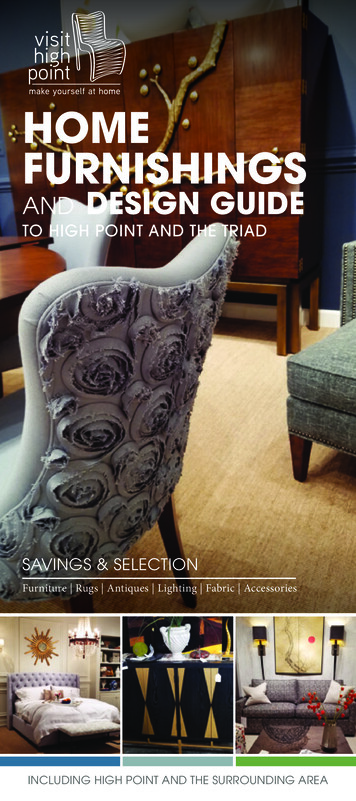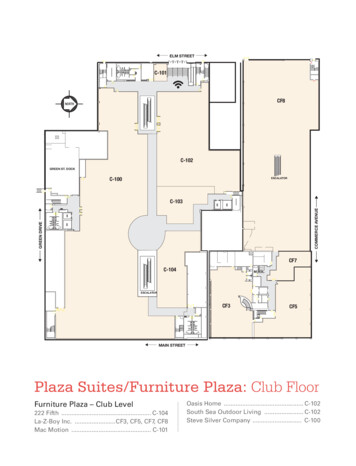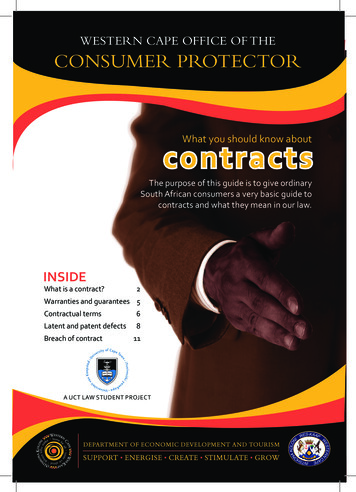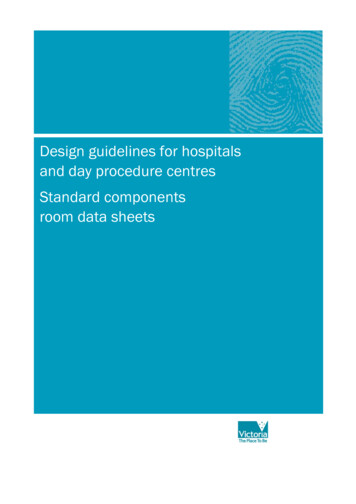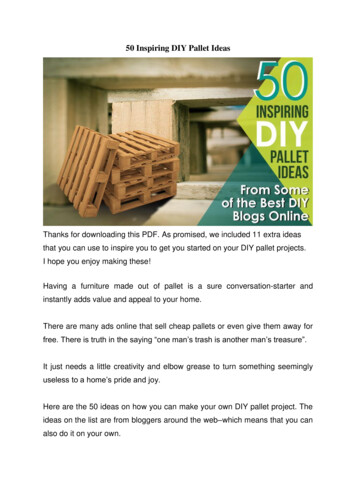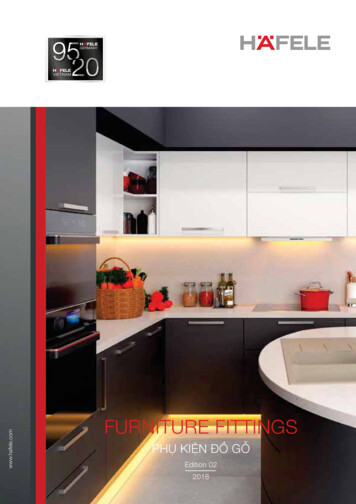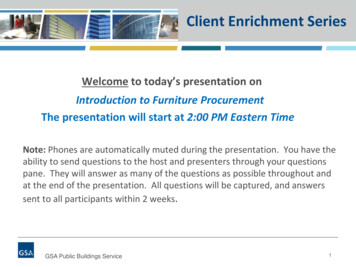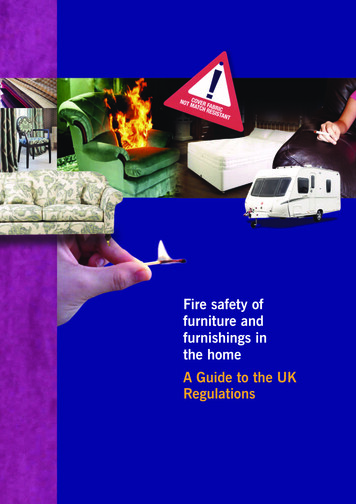
Transcription
Fire safety offurniture andfurnishings inthe homeA Guide to the UKRegulations
Photo courtesy of Wesley-BarrellPhoto courtesy of NovaGarden FurnitureThis Guide was compiled by the Furniture Industry ResearchAssociation (FIRA) in collaboration with the Executive of theBritish Furniture Confederation (BCFA, NBF and BFM).Thanks are also extended to all other organisations andindividuals who contributed to the Guide.Front cover photographs courtesy of Wesley-Barrell, Romo, Relyonand The Swift Group. FIRA International Ltd. 2009All efforts have been made to ensure this document is correct at thetime of going to press. The opinions and advice expressed are givenin good faith. However, the authors cannot be held responsible forany action resulting from the contents of this Guide as the ultimateinterpretation of the Regulations rests with the Courts. Where seriousdoubt occurs professional legal opinion should be sought.Designed by Riga Design & Advertising. www.rigadesign.co.ukFire safety of furniture and furnishings in the home A Guide to the UK Regulations
ForewordI am pleased to providethe foreword for thiscomprehensive Guide toUK flammabilityregulations. It is a mark ofthe considerable andprogressive work of theBritish FurnitureConfederation (BFC), andrepresents the activenature of the British furniture industry as a whole.The Guide has been prepared in consultation with the AllParty Parliamentary Furniture Group (APPFG) and is intendedto build upon the previous DTI publication, A Guide to theFurniture and Furnishings (Fire) (Safety) Regulations, andmore recent UK and European developments.The previous guide on the flammability of furniture andrelated materials has historically been seen as a vitaldocument for anyone involved in the supply or sale offurniture. However, times move on and an update isnecessary to reflect the changes and precedents that haveoccurred in the intervening period.The UK flammability regulations have been in existencefor over 20 years and in 2000 it was estimated that theyhad saved up to 1860 lives since their introduction.However, these requirements are complex and the BFC feltthat there was a need to produce an updated Guide while weawait the promised revision to the Regulations. This Guidehelps to clarify ambiguities, addresses misinterpretationsand outlines the responsibilities of all those involved in thesupply, manufacture and retailing of upholstered furniture.We must not underestimate the importance of ensuringthat modern British furniture, and furniture imported into theUK, is made to the most exacting standards. Iwholeheartedly support the efforts of the BFC, and warmlywelcome this guide.Madeleine Moon MPChair of the All Party Parliamentary Furniture GroupFire safety of furniture and furnishings in the home A Guide to the UK Regulations12.0
PrefaceHaving been heavilyinvolved with theflammability of upholsteredfurniture for over 25years, including thedevelopment of UK’sFurniture & Furnishings(Fire) (Safety) Regulationsin 1988, and through mywork at a large upholsterygroup, I understand how profoundly important the Regulationshave been in saving lives since their introduction.I also appreciate how difficult these Regulations are tointerpret for the layman. This has been compounded overrecent years with the introduction of new products andprocesses that were not around when the Regulations werefirst drafted over twenty years ago.While some of the changes can only be addressed in arevision of the Regulations themselves, this British FurnitureConfederation Guide goes a long way to simplifying the verycomplex issue of fire safety in furniture, and includesexplanations of many of the anomalies that often causeconfusion. Using the most up to dateinterpretations, and incorporating the decisions ofthe courts, guidance from Trading StandardsOfficers and industry best practice, this Guide is anessential reference document for anybody involvedin the supply chain for upholstered domesticfurniture in the UK, including material suppliers,furniture manufacturers, importers, re-upholsterersPhoto courtesy of The Swift Groupand retailers.I whole heartedly recommend this guide to the industry.Dr David HawkridgeIndependent flammability & upholstery expertPhoto courtesy of RelyonPhoto courtesy of Wesley-BarrellFire safety of furniture and furnishings in the home A Guide to the UK Regulations
ContentsContents10.2.1 Holiday homes and furnishedresidential properties20210.2.2 Chalet hotels and holiday apartments20310.2.3 Sheltered accommodation, care homesand student accommodation203.1 Summary of the Regulations310.2.4 Canal boats and pleasure craft213.2 Suppliers affected by the Regulations31.0 Introduction12.0 Definitions3.0 Furniture and Furnishings (Fire) (Safety)Regulations 1988 (amended 1989 and 1993)3.3 Legal aspects of the Regulations54.0 Product ranges covered by the Regulations65.0 Testing: Responsibilities of manufacturers,importers and retailers75.1 General testing requirements75.2 Testing frequency95.3 Specific testing requirements95.3.1 Manufacturers and importers95.3.2 Retailers96.0 Labelling: Responsibilities of manufacturers,importers and retailers106.2 Specific requirements for display labels116.3 General permanent labelling requirements6.4 Specific requirements for permanent labels116.4.2 Retailers136.5 Inspection of information7.0 Record keeping: Responsibilities ofmanufacturers, importers and retailers2110.5 Persons who supply furniture forstatutory functions21A1 Group A2225A1.2 Beanbags and floor cushions25A1.3 Nursery furniture25A1.4 Second-hand furniture26A1.5 Headboards, footboards and side-rails of beds2627A2.1 Garden and outdoor furniture27A2.2 Caravan furniture27A2.3 Cane furniture27A3 Group C1325A1.1 Sofa-beds, futons and other convertiblesA2 Group B131310.4 AuctioneersAppendix 1Specific information and exceptions for product ranges 25116.4.1 Manufacturers and importers212111.0 Useful contacts and acknowledgements106.1 General display labelling requirements6.2.1 Manufacturers, importers and retailers10.2.5 Caravans10.3 Landlords, estate agents and letting agents28A3.1 Mattresses, divans and bed bases28A3.2 Pillows28A3.3 Bedding items2814A3.4 Mattress pads (toppers) and protectors297.1 Record keeping147.2 Specific requirements14A3.5 Ticking fabric and cover fabrics for bed-basesand mattresses297.2.1 Manufacturers and importers147.2.2 Retailers148.0 Specific responsibilities relating to upholsterycomponent suppliers158.1 Suppliers of foam and non-foam filling materials8.1.1 Foam fillings8.1.2 Composite fillings8.2 Suppliers of fabricsA4 Group DA4.1 Scatter cushions and seat padsA5 Group E292930A5.1 Permanent, loose and stretch covers3015A5.2 Covers for furniture3015A5.3 Prime covers3116A5.4 Non-visible parts of furniture3117A6 Group F328.2.1 Match resistant covers17A6.1 Foam fillings328.2.2 Cigarette resistant upholstery18A6.2 Non-foam fillings329.0 Specific responsibilities relating tore-upholsterers19Appendix 2Frequently Asked Questions3310.0 Specific responsibilities relating toother sectors20References41Notes4210.1 Charities2010.2 Letting20Fire safety of furniture and furnishings in the home A Guide to the UK Regulations
Back to contents page
1.0IntroductionThe number of UK fire-related deaths in the homeThe Guide has been formulated using the independentshowed an increasing trend from the 1960s to the lateexpertise of FIRA which has been testing and advising on1980s. These deaths rose from 400 per year at the startflammability issues since before the inception of theof 1960 to 700 by the end of the decade with furtherRegulations, with valuable contributions from the Executiveincreases in the 1970s. A gradual decrease was observedof the BFC and the wider industry. The opinions and advicein the 1980s however the number of domestic fire-relatedexpressed reflect this combined expertise and are given indeaths in 1988 was still 731 per year.good faith. However, the authors cannot be held responsibleAs a response to these worrying statistics, the UKfor any action resulting from the contents of this Guide asGovernment took action through the introduction of thethe ultimate interpretation of the Regulations rests with theFurniture and Furnishings (Fire) (Safety) Regulations 1988Courts. Where serious doubt occurs professional legal(amended 1989 and 1993) alongside previously publishedopinion should be sought.material and campaigns regarding fire safety in the home.Government commissioned research conducted sinceOriginal text from the Department for Business,Enterprise & Regulatory Reform (BERR - formerly DTI)the introduction of the Regulations indicates that by 2000publication “A Guide to the Furniture and Furnishings (Fire)at least 710 lives have been saved (1,860 if other factors(Safety) Regulations” has been used where appropriate. It isare taken into account) and the number of injuries reduced.important to note that it is not the intention of this Guide toHowever, twenty years on, it is clear from the high numberreplace the Regulations.of enquiries received by the British Furniture ConfederationThe Regulations, and this Guide, do not cover the(BFC) members that the industry does not have a fullrequirements for upholstered product used in a non-understanding of what needs to be done to ensure productdomestic environment (e.g. offices, schools, hotels,compliance, and which tests apply to which products. Inhospitals etc). Such uses are covered by the Regulatoryaddition, there are still many products, especially importedReform (Fire Safety) Order 2005.items, which do not comply. Changes in materials usage,plus novel products, design and technologies and a growthin imports mean that vigilance is still required to ensure allthose responsible understand their obligations.Failure to comply with product safety requirements could lead toprosecution. Pleading ignorance is not accepted as a defence.This Guide intends to: Outline the Regulations Reflect the current practice and changes in the industry Clarify and address areas of current debate, anomalies and ambiguities which often result inmisinterpretation of the Regulations Outline the responsibilities of different organisations in the furniture supply chain such as manufacturers,importers and retailersFire safety of furniture and furnishings in the home A Guide to the UK RegulationsBack to contents page1
2.0DefinitionsFor the purposes of this Guide, thefollowing definitions are used:Domestic Upholstered FurniturePillowFurniture that has a filling material inside a cover and isThe item used on a bed to support a sleeper’s head.destined for private use in a domestic dwelling hence fallsRegulationswithin the scope of the Regulations.The Furniture and Furnishings (Fire) (Safety) RegulationsEnforcement Officers1988 (amended 1989 and 1993).Trading Standards Authority Enforcement Officers.RetailerSupplier of products to the consumer through differentFillingAny material that is used in and on furniture to pad, fill oroutlets such as high street shops, online shopping, mailorder traders and wholesalers. Supply of items is notbulk out the cover.confined to retail sales but includes supplying on loan,holding and displaying for supply, or other forms of supply,First supplier of upholstered domesticfurniture in the UKeven where no charge is made (e.g. gifting).The person that is responsible for ensuring that theSchedules (1, 2, 3, 4, 5, 6 and 7)of the RegulationsRegulations are met (i.e. manufacturers, importers orretailers as discussed in Section 3.2).Provide detail regarding the testing and labellingrequirements of items defined in the main body of theFRRegulations.Fire or flame retardantUKASGPSRUnited Kingdom Accreditation Service, the NationalGeneral Product Safety Regulations 2005.Body in the UK authorised to accredit test laboratoriesImporterto the International Standard for quality – BS EN ISO/IECFirst supplier of furniture manufactured outside of the UK.ManufacturerPerson within the UK responsible for completing theconstruction of the furniture. This includes instances17025: 2005.Upholstered furniture covers Visible fabric - the exterior cover of a piece offurniture that is not hidden during normal use.where the manufacturer produces goods against aretailer’s exclusive ‘own-brand’ specification. Non-visible fabric - part of the exterior cover of apiece of furniture that is hidden during normal usebut which can be revealed by removing a loosecushion or by turning the item over (e.g. fabricunderneath a chair or sofa, a platform clothor the reverse of a non-reversible cushion).These fabrics are termed as ‘invisible’in the Regulations.Photo courtesy of Wesley-Barrell2Back to contents pageFire safety of furniture and furnishings in the home A Guide to the UK Regulations
Furniture and Furnishings (Fire) (Safety)Regulations 1988 (amended 1989 and 1993)3.1 Summary of the RegulationsThe Furniture and Furnishings (Fire) (Safety) Regulations3.03.2 Suppliers affected by theRegulations1988 (amended 1989 and 1993) are UK law and areThe Regulations apply to all persons in the businessdesigned to ensure that upholstery components andsupply chain from the supply of materials for use incomposites used for furniture supplied in the UK meetfurniture through to the supply of the finished article asspecified ignition resistance levels.well as re-upholstery and re-covering.They affect:There are six main elements containedwithin the Regulations:1 Persons who supply furniture, furnishings or reupholstery services including: ManufacturersFilling materials must meet specified ignition Retailersrequirements2Upholstery composites must be cigarette resistant3Covers must be match resistant (with certain Importers Persons who supply filling materials and fabrics tothe furniture industry or direct to consumersexceptions as outlined in Section 8.2 and Persons who supply re-upholstery andAppendix A5)4re-covering servicesA permanent label must be fitted to every item of Persons who supply second-hand furniture in thenew furniture (with the exception of mattressesand bed-bases)56course of business or trade (e.g. auctioneers,charities).A display label must be fitted to every item of newfurniture at the point of sale (with the exception ofThe Regulations also apply to persons who hire out furnituremattresses, bed-bases, pillows, scatter cushions,in the course of a business. This embraces furnitureseat pads, loose covers sold separately from theincluded in accommodation let in the course of business,furniture and stretch covers)such as holiday homes and residential furnished lettingsThe first supplier of domestic upholstered furniture(including houses, flats and bed-sits). As such, thein the UK must maintain records for five years toRegulations apply to landlords, estate agents and lettingprove compliance.agents who let such accommodation.The first supplier of domestic upholstered furniture inthe UK is the person responsible for ensuring that theRegulations are met. In this context, the definition of theThe requirements regarding testing and labelling of itemsare detailed in Schedules 1-7 of the Regulations. Schedulesfirst supplier in the UK with respect to manufacturers,importers and retailers is explained in Figure 1.1-5 provide detailed information regarding the testingrequirements for foam and non-foam fillings, composites,interliners and covers. Schedules 6-7 provide detailedinformation regarding the display and permanent labelling ofthe final item.Fire safety of furniture and furnishings in the home A Guide to the UK RegulationsBack to contents page3
Furniture and Furnishings (Fire) (Safety)Regulations 1988 (amended 1989 and 1993) Figure 1 Definition of the first supplier in the UKManufacturers Are you a UK baseddomestic upholsteredfurnitureYesMANUFACTURER?You are the first supplier inthe UK and responsible forensuring compliance with theRegulationsYou assume the roles andresponsibilities of an IMPORTERas first supplier in the UK and areresponsible for ensuringcompliance with the RegulationsRetailers Are you a UK baseddomestic upholsteredfurnitureRETAILER?NoYesDo you direct source domesticupholstered furniture fromoutside the UK to supplyinside the UK?YesDo you purchase domesticupholstered furniture through anindependent importer?YesNoYou are not the first supplier inthe UK however as a RETAILERyou do have some responsibilitiesfor ensuring complianceImporters Are you a UK baseddomestic upholsteredfurnitureIMPORTER?YesYou are the first supplier inthe UK responsible forensuring compliance withthe RegulationsPhoto courtesy of Romo4Back to contents pageFire safety of furniture and furnishings in the home A Guide to the UK Regulations
Furniture and Furnishings (Fire) (Safety)Regulations 1988 (amended 1989 and 1993)3.0Pleading ignorance to the requirements of the3.3 Legal aspects of the RegulationsRegulations and the GPSR is not accepted as a defence. If aThe Regulations are the Statutory Instrument of theproduct is shown to not meet the Regulations, theConsumer Protection Act 1987 relating to the fire safety ofenforcement officers will look for evidence of due diligence –domestic upholstered furniture. Whether or not an item isthat is to say demonstrable evidence that all reasonablecovered by the Regulations, the suppliers of domesticsteps were taken to ensure that any risk was minimised.furniture also still need to ensure that the items are deemedAppropriate testing and supporting documentation can be a‘fit for purpose’, of ‘satisfactory quality’ and ‘safe’ incrucial part of a due diligence defence. It is not an absoluteaccordance with the General Product Safety Regulationsdefence, but if all reasonable steps to avoid committing the2005 (GPSR). The GPSR aim to ensure that all productsoffence have been taken it may be looked on favourably byintended for, or likely to be used by consumers undera court.normal or reasonably foreseeable conditions are safe.All suppliers of domestic upholstered furniture andThe Local Authorities Coordinators of RegulatoryServices (LACORS) promotes the 'Primary Authority'furnishings are responsible, with little defence, for productprinciple. This means that advice and support should beliability under the Consumer Protection Act 1987. Thereforesought from enforcement officers who are located in thesuppliers of domestic upholstered furniture and furnishingssame area as the supplier’s registered place of businessneed to meet the requirements of the Furniture and(e.g. head office).Furnishings (Fire) (Safety) Regulations 1988 and the GPSRIt is the responsibility of enforcement officers to enforceas it is illegal to supply goods that do not comply. Thisthe Regulations. They have the power to select productsremains the case whether the furniture is manufactured infrom retail outlets at random and, should the item fail tothe UK or imported.comply, to bring a prosecution. It is in the suppliers' owninterests to discuss at an early stage with their primaryNon-compliance with the Regulations andthe GPSR may result in: Substantial finesauthority any problems they may have in applying theRegulations, and under the GPSR it is a requirement forsuppliers to report any safety issues to the PrimaryAuthority. Criminal prosecutionAlthough overseas suppliers cannot be prosecuted by Civil claimsthe UK courts, an understanding of the UK Regulations is Product recallsfalling foul of the law. Furthermore, it is the responsibility ofIt is a criminal offence to supply goods to the public whichare not safe and an offence can be deemed to have beencommitted even if nobody has been injured. Recall of itemsessential to minimise the risk of the importer and retailerthe first supplier of the furniture in the UK to ensure thattheir overseas supplier understands the requirements of theRegulations.already sold may therefore be required to avert furthercriminal or civil claims.In addition to the substantial cost implications of anyfines, criminal prosecution, civil claims and product recalls,the damage and effect on future sales that such action maybring to a company’s reputation and product brand canbe significant.Fire safety of furniture and furnishings in the home A Guide to the UK RegulationsBack to contents page5
4.0Product ranges covered by the RegulationsProducts covered by the Regulations comprise six groups (Table 1). Table 1 Range of domestic upholstered furniture and furnishingsItem groupItems within groupAAll types of upholstered seating including chairs, settees, padded stools and ottomans, children’s furniture,foot stools, sofa-beds, futons and other convertibles, bean bags and floor cushionsNursery furniture and upholstered items designed to contain a baby or small childDomestic upholstered furniture that is supplied in kit form for self-assemblySecond hand furnitureUpholstered head-boards, footboards and side rails of bedsBFurniture for use in the open air (garden and outdoor furniture) which is suitable for use in adwelling (homes and caravans)Upholstery in caravans (although not vehicles or boats)Cane furniture which includes upholsteryCDEDivans, bed-bases, mattresses, pillows, and mattress pads (toppers) FILLING MATERIAL ONLY*Scatter cushions and seat pads FILLING MATERIAL ONLYPermanent covers for furniture (textiles, coated textiles, leather etc)Loose and stretch covers for furnitureCovers for non-visible parts of furnitureFFoam and non-foam filling material for furnitureFor the products listed in Group C, the Regulations apply to filling material only. However the complete product shouldconform to the low hazard category of BS 7177 to comply with the requirements of the GPSR.*All furniture and products in the above groups need tocomply with the Regulations. The specific information andexceptions to each group are discussed separately inAppendix 1.The Regulations do not apply to furniture intended forexport and furniture manufactured prior to 1950.The Regulations do not apply to sleeping bags, bedclothes (including duvets), loose covers for mattresses (i.e.mattress protectors), pillowcases, curtains and carpets.However, it is important to note that these products arecovered under GPSR.Photo courtesy of Relyon6Back to contents pageFire safety of furniture and furnishings in the home A Guide to the UK Regulations
Testing5.0Responsibilities of manufacturers, importers and retailers5.1 General testing requirementsManufacturers, importers and retailers in theUK need to ensure that: Furniture is not supplied which contains foamfillings (block or crumb polyurethane or latexrubber) that do not meet the requirements outlinedin Schedule 1 of the Regulations. Furniture is not supplied which contains non-foam Furniture is not supplied with upholstery compositesfillings that do not meet the requirements outlinedthat do not pass the cigarette test as outlined inin Schedule 2 of the Regulations.Schedule 4 of the Regulations. Composite fillings consisting of more than one Furniture is not supplied with permanent, loose orfilling material comply either by each individualstretch covers which do not pass the match test asfilling separately complying or by the totaloutlined in Schedule 5 of the Regulations.incorporated in the composite must comply withThe testing requirements for items are summarised inSchedule 1 of the Regulations.Tables 2 and 3.Table 2 Summary of testing requirements for fillings as outlined in the Regulation SchedulesSchedule 1Filling type composite being tested. In either case, any foamSchedule 2Part 1 Part 2 Part 3 Part 1 Part 2 Part 3 Part 4Foam:Polyurethane, Slab or cushionPolyurethane, crumbLatex rubberNon-foam:Single fillingComposite fillings:Furniture*Pillows/Scatter Cushions*Mattresses*Futons*If there is foam in these products, it should also be tested to Schedule 1, Part 1 in addition to the testing schedulesmarked in Table 2.*Fire safety of furniture and furnishings in the home A Guide to the UK RegulationsBack to contents page7
TestingResponsibilities of manufacturers, importers and retailers Table 3 Summary of testing requirements for interliners, upholstery and covers as outlined in theRegulation SchedulesSchedule 3MaterialSchedule 4Schedule 5Part 1 Part 2 Part 1 Part 2 Part 3WatersoakUpholstery composites (Cigarette Resistance)Visible: FR treatedVisible: Non-FR treatedNon-visible: FR and non-FR treatedCovers (Match Resistance)Visible/Permanent: FR treatedVisible/Permanent: Non-FR treatedNon-visible: FR and non-FR treatedLoose: FR treatedLoose: Non-FR treatedStretchFire-Barriers/interlinersFR treatedNon-FR treatedIt is recommended that any testing should be conducted bycompliance with the Regulations and in somea UKAS or similar accredited test laboratory. Testcircumstances the Regulations may not require fulllaboratories should be specifically accredited for the full setconformance to the British Standard. Tests should alsoof bed/mattress/furniture and foam/fillings fire testing. So forprovide traceability to product batches.example if importing mattresses and beds then the importerIn this context it is important to note that testing ofshould ensure that the test laboratory is specificallydomestic upholstered furniture which is covered by theaccredited for tests for both the Regulations and BS 7177.Regulations is linked to the specific versions of the BritishFurthermore, it is strongly recommended that any testStandards outlined in Schedules 1-5 of the 1988reports or certificates issued by these test houses shouldRegulations (i.e. not the latest issue of the Britishindicate compliance, not with the British StandardStandard specification).specifications, but with the appropriate Schedule to theRegulations, since these Schedules are the true definition ofwhat is required and incorporate modifications to testprocedures where necessary. A test strictly in accordancewith the British Standard may be no guarantee of8Back to contents pageFire safety of furniture and furnishings in the home A Guide to the UK Regulations
TestingResponsibilities of manufacturers, importers and retailers5.2 Testing frequency5.0It is advisable for manufacturers, importers and retailersto carry out regular spot checks to ensure materials continueInitial testing when the product is first introduced does notto meet requirements. The testing frequencynecessarily guarantee on-going compliance. In effect, testrecommendations outlined previously should be used asdata applies to the item evaluated; not to the actual itema guide.supplied. Therefore, it is essential that there is anadequate, planned re-testing regime in place.Frequency of testing is not covered by the Regulations.Finally, documentation regarding quality assurance andtraceability should be readily available to the enforcementofficers on request.The appropriate frequency of testing is dependent on theIn addition to these general requirements; there arevolume of the product that is produced and should be basedsome differences between the responsibilities ofupon a risk assessment. It is the supplier’s responsibility tomanufacturers, retailers and importers in terms of productassess the risk and decide on the frequency of testingtesting. These differences are discussed in Section 5.3.required for a certain product.However manufacturers, importers and retailers are5.3 Specific testing requirementsadvised to remember that enforcement officers expect to seea test certificate from a UKAS, or similar, accredited5.3.1 Manufacturers and importerslaboratory, which is no more than 1 year old and preferablyManufacturers and importers who are the first supplier of theless than 6 months old.upholstered furniture in the UK have responsibilities underIn addition there is a frequency of testing requirement inthe Regulations for ensuring that no domestic upholsteredBS 7176 (non-domestic seating) and BS 7177 (mattresses,furniture is supplied which contains non-compliantdivans and bed bases). It is recommended that any riskupholstery materials or composites. It must be ensured thatassessment to determine a suitable frequency of testingall requirements of the Regulations are met.Should a furniture component contain foam, non-foamprogramme to satisfy the Regulations should take account ofthis information. Hence, it is recommended that productsfillings and/or cover materials, which have been importedshould be tested once every 2500 units for seating, 2400 forinto the UK for incorporation into UK manufacturedmattresses or once per month whichever is most practicable.furniture, then it is recommended that each batch beIn the case of mattresses, divans and bed bases, wheresupported by documentary evidence of compliance.conformance to BS 7177 low hazard is claimed, theImporters must ensure correlation and traceabilityfrequency of testing requirement in the standard mustbetween the foam and the furniture in which it is used. It isbe met.not advisable to rely solely on the tests conducted byManufacturers, importers and retailers are responsible foroverseas suppliers or manufacturers unless there is acompliance and are therefore advised to seek reassuranceguaranteed system of traceability and conformance in place.concerning the validity of any test certificate provided byImporters should check the authenticity of any testsuppliers or third parties. Manufacturers, importers andcertificates provided by suppliers, which should ideally beretailers are dependent on suppliers to provide compliantfrom a laboratory accredited to BS EN ISO/IEC 17025 byfillings and should ask for current copies of full test resultsUKAS or a similar national accreditation body.(i.e. not abbreviated ones) on an ongoing basis. Somepurchasers incorporate requirements into purchase orders,5.3.2 Retailersstipulating that quality and make-up of products are not to beRetailers are not expected to be responsible for testingaltered without prior notice, and to seek written assuranceupholstered products unless actin
nature of the British furniture industry as a whole. The Guide has been prepared in consultation with the All Party Parliamentary Furniture Group (APPFG) and is intended to build upon the previous DTI publication, A Guide to the Furniture and Furnishings (Fire) (Safety) R
